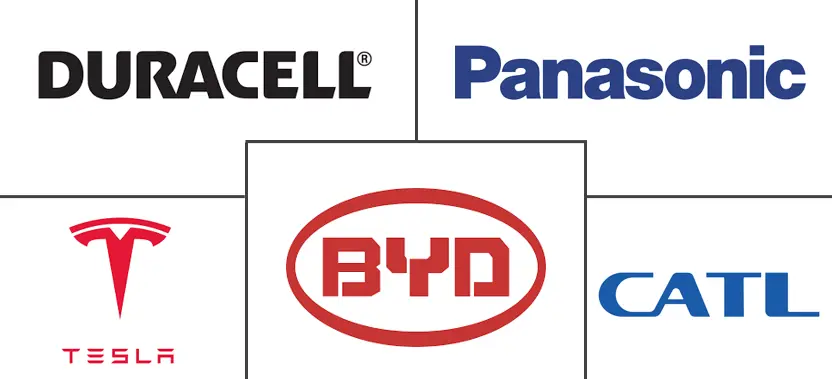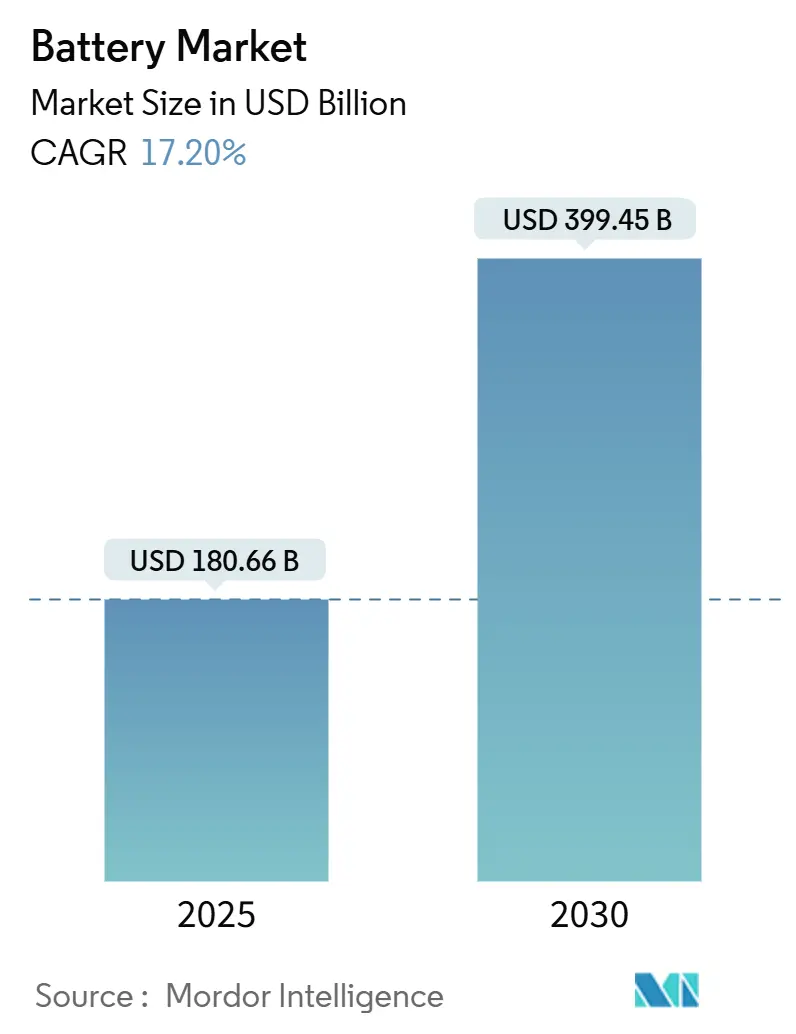
Battery Market Analysis by Mordor Intelligence
The Battery Market size is estimated at USD 180.66 billion in 2025, and is expected to reach USD 399.45 billion by 2030, at a CAGR of 17.20% during the forecast period (2025-2030).
- Over the long term, factors such as the declining lithium-ion battery prices and the growing usage of batteries in electric vehicles are expected to drive the market.
- On the flip side, a mismatch in the demand and supply of raw materials for battery manufacturing is likely to hinder the market growth.
- As solar energy is an intermittent source and generates power only during the daytime, using off-grid solar power in conjunction with energy storage substantially enhances the utilization of solar PV units. As a result, energy storage with solar PV has been gaining popularity in developed countries, which is likely to create a huge opportunity for the battery market in the near future.
- Asia-Pacific is expected to dominate the battery market, with most of the demand coming from China, India, Japan, and South Korea.
Global Battery Market Trends and Insights
Automotive Batteries to be the Fastest Growing Segment
- Once dominated by internal combustion engines (ICE), the automotive landscape is now pivoting towards electric vehicles (EVs), driven by mounting environmental concerns. Lithium-ion batteries, favored for their high energy density, lightweight nature, and low maintenance, have become the standard in EVs.
- Europe stands as a key player in the electric vehicle arena. The continent's swift embrace of EVs is fueling a heightened demand for cutting-edge battery technologies. This electrification drive, underpinned by stringent emission norms, financial incentives, and a robust commitment to sustainability, sees a collaborative effort from governments, automakers, and consumers alike. Initiatives like the European Union’s Green Deal and national policies championing zero-emission vehicles are further propelling this shift.
- As per the International Energy Agency (IEA), Europe recorded a notable uptick in electric vehicle sales in 2024, with figures hitting 3.4 million units. This represents a 6.25% rise from 2022 and an impressive 34-fold increase since 2014. Given the European Union's ambitious Green Deal, which aims for climate neutrality by 2050, a continued surge in EV sales is on the horizon.
- Moreover, global advancements in battery technology and charging infrastructure are bolstering EV adoption rates. In response to the escalating demand for electric vehicles, manufacturers worldwide are ramping up investments in battery production, seeking to optimize their processes.
- Meanwhile, Brazil is emerging as a leader in Latin America's shift towards sustainable energy and economic decarbonization. In a significant move, Bravo Motor Company Brasil, a prominent player in EV technology, sealed a deal in August 2024 to set up the region's first-ever lithium-ion battery gigafactory.
- With electric vehicle sales on the rise and a burgeoning number of battery plants sprouting up, the global market is poised for substantial growth in the coming years.
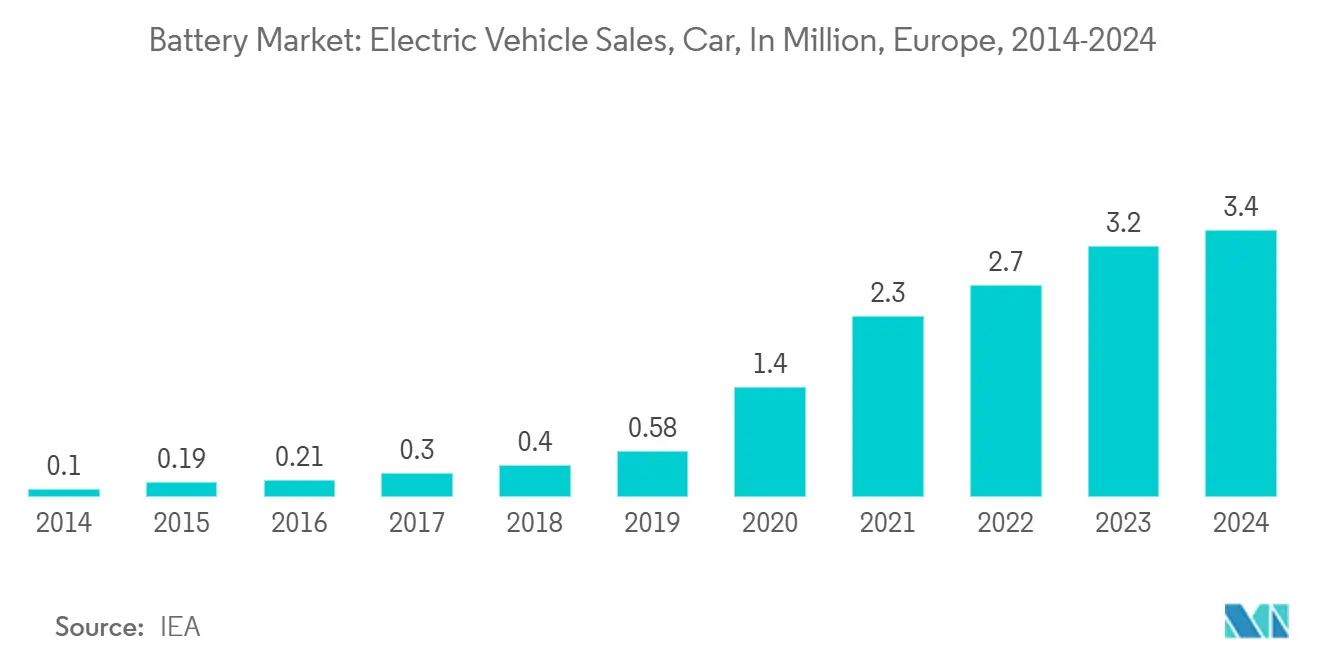
Asia-Pacific is Expected to Dominate the Market
- Asia-Pacific's battery market is surging, fueled by the rising embrace of electric vehicles (EVs), the expansion of renewable energy initiatives, the growing demand for energy storage systems (ESS), and breakthroughs in battery technology.
- China, a heavyweight in the global data arena, is witnessing a meteoric rise in the demand for data storage, processing, and distribution. This boom in data center construction is propelled by China's ambition to dominate the digital infrastructure landscape, with both state-owned and private enterprises pouring investments into new data center developments.
- In February 2025, China unveiled a major investment in AI-centric data centers, rallying tech firms and startups to bolster state-owned facilities with advanced AI chips. This partnership seeks to amplify the prowess of these centers, tackling the intricacies of AI chip cluster management and performance optimization. By mid-2024, China had either wrapped up or kicked off the construction of several AI data centers, with substantial backing from local government bonds.
- The burgeoning data center landscape in China is amplifying the demand for sophisticated energy storage solutions, propelling the battery market's growth, particularly in renewable energy storage and backup power systems for essential infrastructure.
- Futhermore, Japan's surge in battery cell giga-factories marks a pivotal moment in the global energy and automotive landscape, as the nation carves out its niche in the booming electric vehicle (EV) sector. With automotive giants like Toyota, Honda, and Nissan calling Japan home, the nation is acutely aware of the strategic significance of lithium-ion batteries in the EV revolution.
- Japan's battery cell gigafactory scene in 2025 boasts Panasonic's established facilities and expansion plans, alongside Toyota's fresh EV battery plant for Lexus in Kyushu. Highlighting this momentum, Toyota Motor, in July 2024, declared its intent to set up an EV battery plant for Lexus on Kyushu island, with its battery manufacturing arm, Primearth EV Energy, poised to helm operations.
- With global EV demand on the upswing, Japan is hastening the establishment of giga-factories for battery cell production, eyeing both domestic supply security and export potential. In a testament to this ambition, the Japanese government greenlit a funding of up to JPY 347.9 bn (USD 2.4bn) in September 2024, targeting EV battery investments. The goal is a robust 150 GWh/yr domestic output capacity by 2030, with allocations of around JPY 32.6 bn for Li-ion battery production (inclusive of lithium iron phosphate or LFP batteries), JPY 17 bn for raw materials like electrolytes, and JPY 5 bn earmarked for manufacturing equipment.
- As the global landscape pivots towards cleaner energy and heightened electrification, Asia-Pacific's aggressive investment in giga-factories signals its dedication to spearheading technological advancements and carving out a sustainable, competitive foothold in the global arenas of electric vehicles and renewable energy storage.
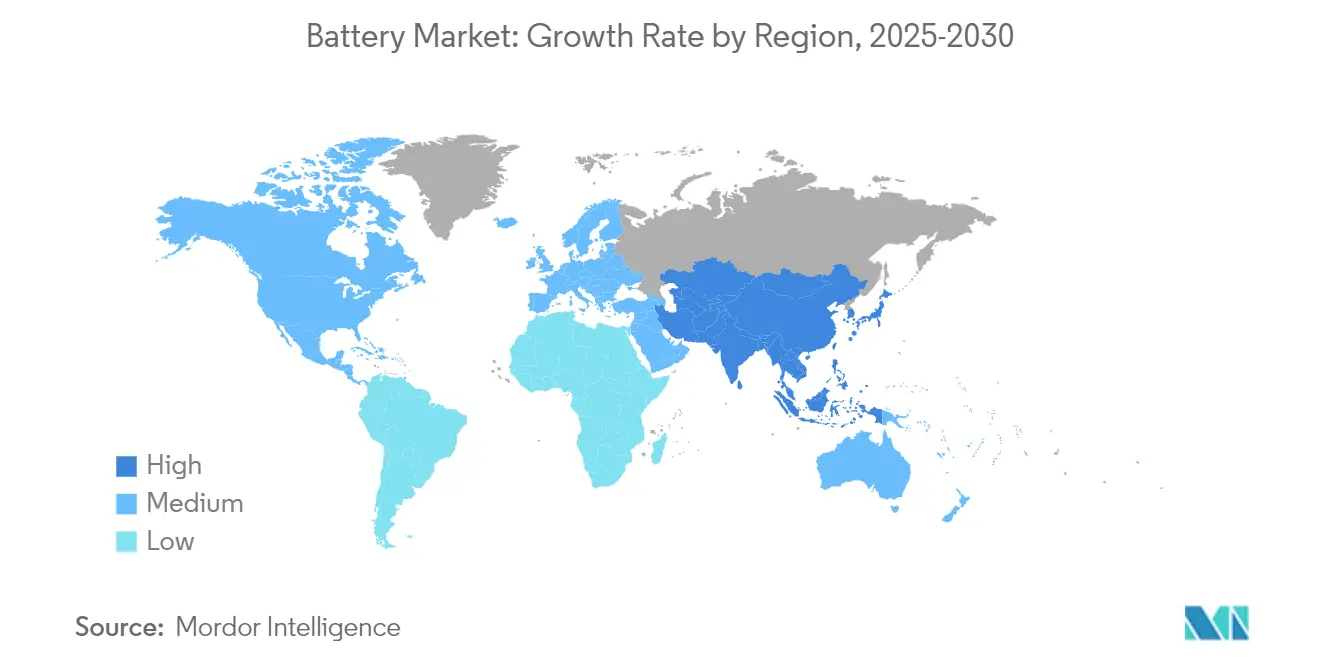
Competitive Landscape
The global battery market is fragmented in nature. Some of the major players in the market (in no particular order) include Contemporary Amperex Technology Co. Limited, BYD Co. Ltd, Duracell Inc., Tesla Inc., and Panasonic Corporation.
Battery Industry Leaders
-
Duracell Inc.
-
Panasonic Corporation
-
Contemporary Amperex Technology Co. Limited
-
BYD Co. Ltd
-
Tesla Inc.
- *Disclaimer: Major Players sorted in no particular order
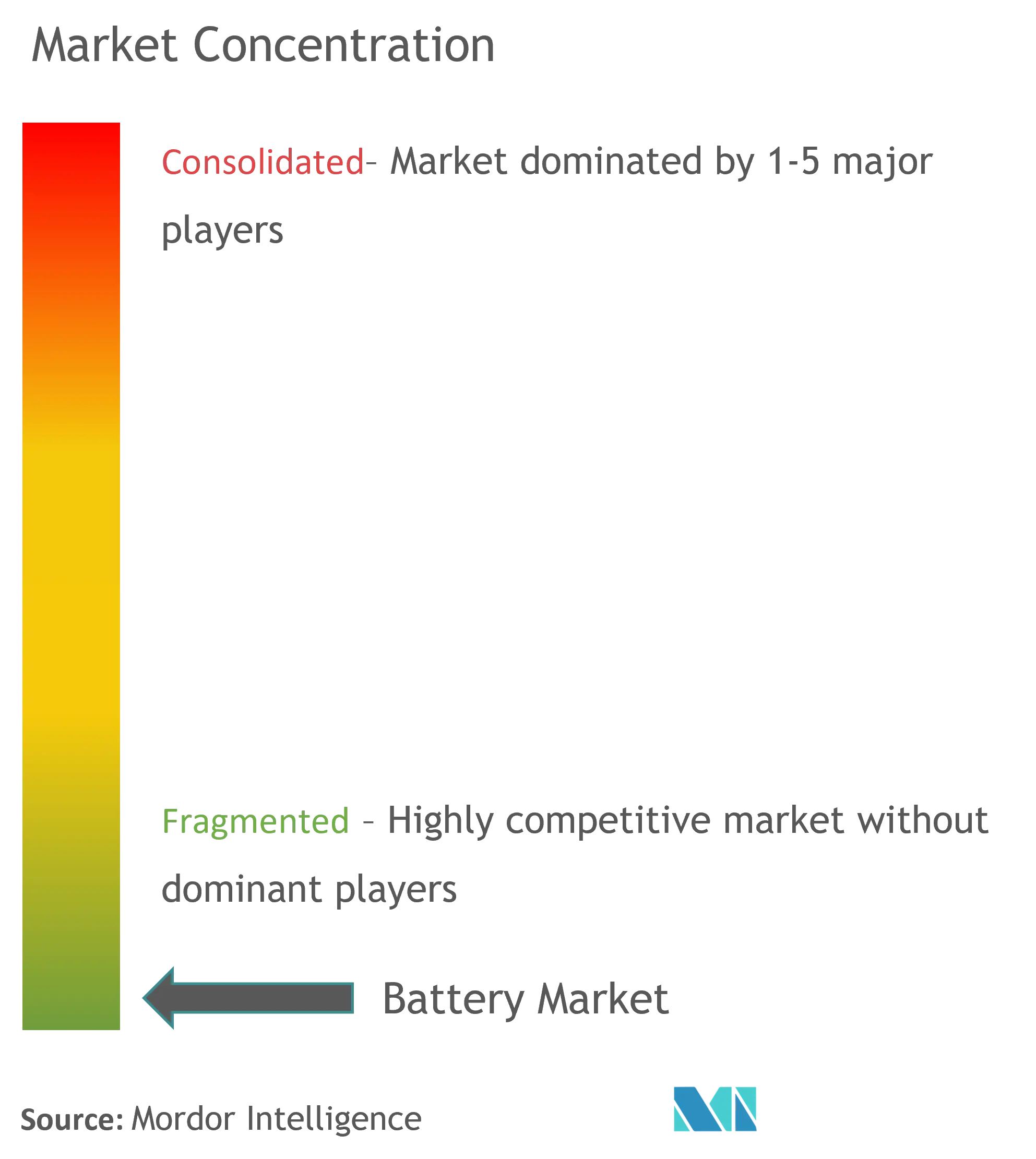
Recent Industry Developments
- March 2025: Vikram Solar, a prominent solar module manufacturer, unveiled its ambitious plans to establish a 1GWh solid-state cell and battery manufacturing facility. The facility, which boasts a proprietary battery management system (BMS), is designed with scalability in mind, allowing expansion up to 5 GWh. Vikram Solar will leverage cutting-edge technology from its partner, Entity2 Energy Storage Ltd., which boasts a portfolio of patents for non-lithium solid-state battery technologies.
- January 2025: Mahindra unveiled a manufacturing and battery assembly facility at its Chakan plant, marking a significant step in its commitment to producing Electric Origin SUVs. Boasting one of the world's most compact battery manufacturing lines, the facility employs patented processes and lean module assembly. This fully automated plant harnesses indigenously developed world-class manufacturing processes, leveraging Industry 4.0 technology to produce, store, and transfer high-performance, long-lasting batteries.
Global Battery Market Report Scope
A battery is a device that converts chemical energy contained within its active materials directly into electric energy by means of an electrochemical oxidation-reduction (redox) reaction.
The battery market is segmented by type, technology, application and geography. By type, the market is segment into primary battery and secondary battery. By technology, the market is segmented into lead-acid battery, lithium-ion battery, nickel-metal hydride (NiMh) battery, nickel-cadmium (NiCd) battery, nickel-zinc (NiZn) battery, flow battery, sodium–sulfur (NAS) battery, zinc-manganese dioxide battery, small sealed lead-acid battery, and other technologies (dual carbon battery, zinc-carbon battery, silver-oxide battery, etc.). By application, the market is segmented into automotive batteries (HEV, PHEV, and EV), industrial batteries (motive, stationary (telecom, ups, energy storage systems (ESS)), etc.), portable batteries (consumer electronics, etc. ), power tools batteries, SLI batteries, and other applications The report also covers the market size and forecasts for the battery market across major regions, such as Asia-Pacific, North America, Europe, South America, the Middle East, and Africa.
For each segment, the market sizing and forecasts have been done based on revenue (USD).
| Primary Batteries |
| Secondary Batteries |
| Lead-acid Battery |
| Lithium-ion Battery |
| Nickel-metal Hydride (NiMH) Battery |
| Nickel-cadmium (NiCD) Battery |
| Nickel-zinc (NiZn) Battery |
| Flow Battery |
| Sodium-sulfur (NAS) Battery |
| Zinc-manganese Dioxide Battery |
| Small Sealed Lead-acid Battery |
| Other Technologies (Dual Carbon Battery, Zinc-carbon Battery, Silver-oxide Battery, etc.) |
| Automotive Batteries (HEV, PHEV, and EV) |
| Industrial Batteries (Motive, Stationary (Telecom, UPS, Energy Storage Systems (ESS)), etc.) |
| Portable Batteries (Consumer Electronics, etc.) |
| Power Tool Batteries |
| SLI Batteries |
| Other Applications |
| North America | United States |
| Canada | |
| Rest of North America | |
| Asia-Pacific | China |
| India | |
| Japan | |
| South Korea | |
| Rest of Asia-Pacific | |
| Europe | Germany |
| France | |
| Italy | |
| United Kingdom | |
| Russian Federation | |
| Rest of Europe | |
| South America | Brazil |
| Argentina | |
| Rest of South America | |
| Middle East & Africa | Saudi Arabia |
| United Arab Emirates | |
| South Africa | |
| Rest of Middle East and Africa |
| Type | Primary Batteries | |
| Secondary Batteries | ||
| Technology | Lead-acid Battery | |
| Lithium-ion Battery | ||
| Nickel-metal Hydride (NiMH) Battery | ||
| Nickel-cadmium (NiCD) Battery | ||
| Nickel-zinc (NiZn) Battery | ||
| Flow Battery | ||
| Sodium-sulfur (NAS) Battery | ||
| Zinc-manganese Dioxide Battery | ||
| Small Sealed Lead-acid Battery | ||
| Other Technologies (Dual Carbon Battery, Zinc-carbon Battery, Silver-oxide Battery, etc.) | ||
| Application | Automotive Batteries (HEV, PHEV, and EV) | |
| Industrial Batteries (Motive, Stationary (Telecom, UPS, Energy Storage Systems (ESS)), etc.) | ||
| Portable Batteries (Consumer Electronics, etc.) | ||
| Power Tool Batteries | ||
| SLI Batteries | ||
| Other Applications | ||
| Geography | North America | United States |
| Canada | ||
| Rest of North America | ||
| Asia-Pacific | China | |
| India | ||
| Japan | ||
| South Korea | ||
| Rest of Asia-Pacific | ||
| Europe | Germany | |
| France | ||
| Italy | ||
| United Kingdom | ||
| Russian Federation | ||
| Rest of Europe | ||
| South America | Brazil | |
| Argentina | ||
| Rest of South America | ||
| Middle East & Africa | Saudi Arabia | |
| United Arab Emirates | ||
| South Africa | ||
| Rest of Middle East and Africa | ||
Key Questions Answered in the Report
How big is the Battery Market?
The Battery Market size is expected to reach USD 180.66 billion in 2025 and grow at a CAGR of 17.20% to reach USD 399.45 billion by 2030.
What is the current Battery Market size?
In 2025, the Battery Market size is expected to reach USD 180.66 billion.
Who are the key players in Battery Market?
Duracell Inc., Panasonic Corporation, Contemporary Amperex Technology Co. Limited, BYD Co. Ltd and Tesla Inc. are the major companies operating in the Battery Market.
Which is the fastest growing region in Battery Market?
Asia-Pacific is estimated to grow at the highest CAGR over the forecast period (2025-2030).
Which region has the biggest share in Battery Market?
In 2025, the Asia-Pacific accounts for the largest market share in Battery Market.
What years does this Battery Market cover, and what was the market size in 2024?
In 2024, the Battery Market size was estimated at USD 149.59 billion. The report covers the Battery Market historical market size for years: 2019, 2020, 2021, 2022, 2023 and 2024. The report also forecasts the Battery Market size for years: 2025, 2026, 2027, 2028, 2029 and 2030.
Page last updated on:
Battery Market Report
The global battery market is poised for significant growth, driven by the high use of UPS devices in sectors such as healthcare, chemical, and oil and gas for continuous power supply. Lead acid batteries are currently favored for their reliability and low cost, but lithium-ion batteries are expected to capture a significant market share due to their low energy density and lightweight. The U.S. market is anticipated to witness substantial growth due to favorable government policies and increasing sales of electric vehicles and consumer electronics. The construction industry is also expected to contribute to market growth, with the demand for UPS in the sector expected to increase. Technological advancements in product innovation, enhanced efficiency, and cost-effectiveness are expected to benefit the market.
The e-mobility industry is set to significantly increase the demand for batteries, with lithium-ion battery solutions likely to dominate. While the automobile sector is currently leading the global battery market, the electronics sector is also a significant contributor. The industrial batteries segment is expected to enhance market growth. Asia Pacific is currently dominating the global market, with most of the demand coming from China, India, Japan, and South Korea. Mordor Intelligence™ provides a comprehensive analysis of the battery market, including a market forecast outlook and a historical overview.
Industry analysis shows promising trends in the market, with a positive industry outlook. The market forecast indicates steady growth, supported by industry research and industry reports. The market overview highlights the significant role of market leaders in driving the market growth. Market segmentation helps in understanding the different applications and technologies within the battery market. The market value is expected to rise, reflecting the increasing demand and advancements in battery technology.
Industry statistics and market data provide a detailed understanding of the market trends and growth rate. Market predictions suggest that the industry size will continue to expand, driven by the growing need for energy storage solutions. The market review and market outlook further emphasize the potential for growth in various sectors. Report examples and report pdfs offer valuable insights and detailed analysis of the market dynamics. Research companies play a crucial role in providing accurate and comprehensive market information.
In summary, the global battery market is on an upward trajectory, with significant contributions from various sectors and regions. The industry trends and market forecast indicate a bright future for the battery market, supported by ongoing research and technological advancements.
